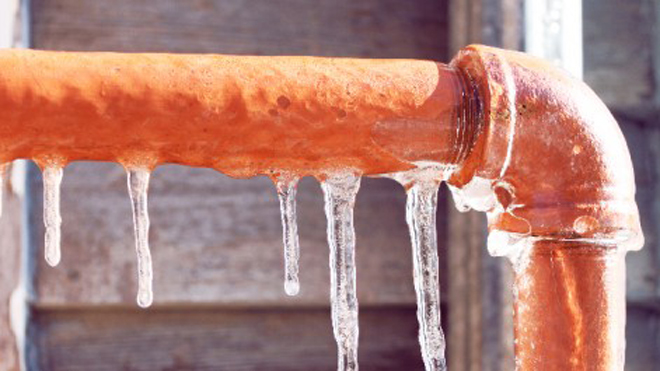How to Protect Your Plumbing from Cold Weather: Essential Tips
How to Protect Your Plumbing from Cold Weather: Essential Tips
Blog Article
We have uncovered this great article involving 6 Ways to Prevent Frozen Pipes listed below on the net and felt it made good sense to discuss it with you over here.

Winter can wreak havoc on your plumbing, especially by freezing pipes. Right here's exactly how to stop it from taking place and what to do if it does.
Intro
As temperature levels decline, the danger of icy pipes boosts, potentially causing expensive fixings and water damages. Understanding how to prevent frozen pipes is crucial for homeowners in chilly climates.
Avoidance Tips
Shielding vulnerable pipelines
Wrap pipes in insulation sleeves or use heat tape to protect them from freezing temperatures. Focus on pipelines in unheated or external locations of the home.
Heating methods
Keep indoor rooms effectively warmed, especially locations with plumbing. Open closet doors to allow warm air to flow around pipelines under sinks.
How to determine icy pipelines
Look for decreased water flow from taps, uncommon smells or sounds from pipes, and noticeable frost on subjected pipelines.
Long-Term Solutions
Structural changes
Take into consideration rerouting pipes away from outside walls or unheated areas. Add extra insulation to attics, basements, and crawl spaces.
Upgrading insulation
Invest in premium insulation for pipes, attics, and wall surfaces. Correct insulation assists maintain consistent temperature levels and minimizes the risk of frozen pipelines.
Securing Outdoor Pipes
Garden hoses and exterior faucets
Detach and drain garden tubes prior to wintertime. Set up frost-proof faucets or cover outdoor faucets with shielded caps.
Understanding Icy Pipelines
What creates pipelines to freeze?
Pipes ice up when subjected to temperatures listed below 32 ° F (0 ° C) for extended periods. As water inside the pipelines ices up, it increases, putting pressure on the pipeline walls and potentially causing them to burst.
Threats and problems
Frozen pipelines can lead to water disruptions, property damage, and pricey repairs. Burst pipes can flood homes and cause extensive architectural damages.
Indications of Frozen Water Lines
Determining frozen pipelines early can avoid them from rupturing.
What to Do If Your Pipes Freeze
Immediate actions to take
If you presume frozen pipes, keep faucets open up to alleviate stress as the ice thaws. Make use of a hairdryer or towels taken in hot water to thaw pipes gradually.
Verdict
Stopping frozen pipes calls for positive actions and fast actions. By comprehending the causes, indicators, and safety nets, property owners can safeguard their pipes throughout winter.
6 Proven Ways to Prevent Frozen Pipes and Protect Your Home
Disconnect and Drain Garden Hoses
Before winter arrives, start by disconnecting your garden hoses and draining any remaining water. Close the shut-off valves that supply outdoor hose bibs and leave the outdoor faucet open to allow any residual water to drain. For extra protection, consider using faucet covers throughout the colder months. It’s also important to drain water from any sprinkler supply lines following the manufacturer’s directions.
Insulate Exposed Pipes
Insulating your pipes is an effective way to prevent freezing. Pipe insulation is readily available at home improvement stores and is relatively inexpensive. Pay close attention to pipes in unheated areas such as the attic, basement, crawl spaces, or garage. Apply foam insulation generously to create a buffer against the cold. You can also wrap your pipes in heat tape or thermostat-controlled heat cables for added warmth.
Seal Air Leaks
Inspect your home for any cracks or openings that could let in cold air. Seal any holes around the piping in interior or exterior walls, as well as the sill plates where your home rests on its foundation. Additionally, make sure to keep your garage door closed unless you’re entering or exiting. Leaving it open creates a significant air leak that can lead to frozen pipes.
Allow Warm Air Circulation
During cold snaps, it’s essential to allow warm air to circulate evenly throughout your home. Leave interior doors ajar to promote better airflow. Open kitchen and bathroom cabinets to help distribute heat consistently around the rooms. If you have small children or pets, be sure to remove any household chemicals or potentially harmful cleaners from open cabinets for safety.
Let Faucets Drip
A small trickle of water can make a big difference in preventing ice formation inside your pipes. When temperatures drop significantly, start a drip of water from all faucets served by exposed pipes. This continuous flow helps prevent the water from freezing. Additionally, running a few faucets slightly can relieve pressure inside the pipes, reducing the chances of a rupture if the water inside does freeze.
https://choateshvac.com/6-proven-ways-to-prevent-frozen-pipes-and-protect-your-home/

I ran across that write up on Winter Plumbing Precautions: Preventing Frozen Pipes while browsing on the web. Please take the time to distribute this write-up if you enjoyed reading it. Thank you so much for going through it.
This Post Report this page